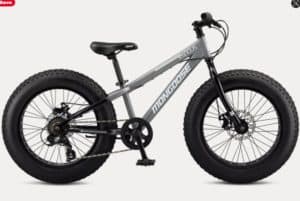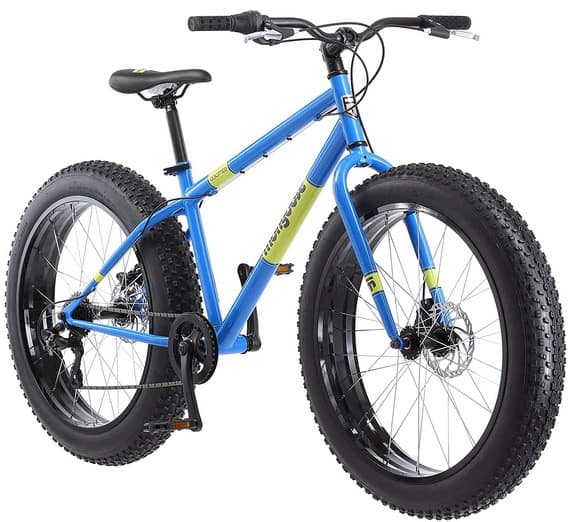Bikes are typically lightweight and sleek in many people’s minds, but there come fat bikes with massive tires. Due to this, you likely wondering what benefit the big tires offer and if it allows a bike to carry more weight. Therefore,
Do Fat Tire Bikes Hold More Weight?
Fat tire bikes hold more weight, with most designed with a maximum weight limit of 300 pounds, while others go to 400 pounds. This is compared to 200 pounds for most standard bicycles. The high weight limit is one of the reasons why many people who weigh more gravitate towards them.
There’s plenty of reasons to embrace fat tire bikes, and their weight capacity is of those reasons.

How Much Weight Can A Fat Bike Hold? (Fat Bikes Weight Limit)
The listed weight limit for most fat tire bikes is 300 pounds, but some can handle up to 400 pounds. There is room to go a bit up but be careful not to over-exert your bicycle that can damage it or even put you in danger as the bike can collapse while on the trail or road.
What you may not realize is, your bike’s weight can quickly get nearly or more than 300 pounds, even when you weigh 200 pounds. This happens when you carry items on your fat bikes, such as a rack, backpack, or even groceries.
It is essential to be cautious when riding your fat bike.
Weight Distribution
The tire maker can indicate the weight limit of tires, and since bicycles have two wheels, each tire carries a particular weight portion.
The weight distribution usually depends on the positioning of the seat, with 60% going to the rear tire and 40% going to the front tire. Therefore, if the tires’ maximum weight limit is 150 pounds each, your bike can handle 300 pounds.
The weight limit of most regular tires is about 100 pounds, with a few going up to 150 pounds. Fat tires, on the other hand, support around 200 pounds.
Check your fat tire bike’s weight limit for both tires, the frame, and consider the weight distribution ratio when determining how much weight your bike can support.
Do Weight Limits Matter?
The weight limit provided for a bicycle by the manufacturer is not the bike’s total failure point. Therefore, you can go a few pounds higher without breaking your bike’s frame.
While that won’t break your fat bike immediately, riding it at, under, or over the stated weight limit lowers your leeway in other areas. For example, if you hit a pothole while on a fat bicycle carrying more than 400 pounds, you may crumple the rim.
Riding your fat tire bike at peak weight capacity constantly creates much wear and tear issues. These include bending the fork, brake pads wearing off faster, and breaking the spokes.
If you keep your fat tire bike well maintained and ensure the tires are properly inflated, you likely won’t experience serious consequences by slightly exceeding the weight limit.

Are Fat Tire Bikes Good For Heavy Riders?
Fat tire bikes are great bike options for heavier riders because of their fatter tires, frames, and wheels. Heavier riders should avoid unisex bicycles and models designed for adults and teenagers because one-size-fits-all bikes don’t usually fit riders of all sizes.
Folding bikes and lightweight bicycles are also not ideal because they cannot support a lot of weight. Additionally, single-speed cruisers are challenging to pedal, and they can exert pressure on your cruiser’s tires, so avoid them too.
Alternatively, you can use road bikes with larger tires.
Here’s why fat tire bikes are great for heavy riders.
1. The Tires
Thin tires don’t bear excessive weight properly because they compress a lot easier upon impact, leading to blowouts, rim damage, flats, and burping.
Fat bikes offer more cushioning and, the increased tire width provides better distribution of weight, making the tires more comfortable and stable.
2. The Wheels
Wheels deal with constant stress, and the pressure from impacts suffered on the road or trail can deform the bike’s rims. Since fat tires are manufactured using sturdy materials, such as steel, they can support more weight.
3. The Frame
The materials used to make a bike’s frame determine its strength, as every material contains its innate stress tolerance. Steel alloy and steel are the strongest; Surly uses 4130 CroMoly steel, which they have patented.
Other brands also use steel to make their fat tires bikes. An excellent example of a steel-framed fat bike to consider is the Mongoose Dolomite Mens Fat Tire Mountain Bike (View on Amazon) with rear and front brakes, rigid suspension, 26 inches wheel size, and available in navy blue, red, and light blue.

Aluminum is used in most bikes today and is resilient to impacts and lightweight. Bike brands like Specialized and Trek produce fat bikes made of aluminum.
Most riders looking for fat bikes go for aluminum frames because a lot of companies use them now. However, remember aluminum may feel more rigid compared to steel, partly because of bigger tube diameters, which makes your bicycle stiffer.
Titanium and carbon fiber are strong materials for frames, but they are more breakable under heavier weight.
Also, read: What Are Fat Bikes Good For?
FAQs
1. Are Fat Tire Bikes Better For Heavy Riders?
Fat bikes provide an extra dampening effect through the fatter tires, making riding more comfortable. In addition, while fat tire bikes are not explicitly designed for heavier riders, they can also hold more weight hence ideal for individuals who weigh more.
You are better off getting a fat tire bike with a broad gear range to make pedaling easier.
2. How Much Weight Can A Fat Bike Carry?
The majority of fat tire bikes carry about 300 pounds, with a few built to support around 400 pounds. Make sure you check your bike’s weight capacity beforehand, and if you must carry beyond its weight limit, do not push it too far to avoid breaking it or getting yourself into severe danger.
In Conclusion, Do Fat Tire Bikes Hold More Weight?
While their primary purpose isn’t carrying more weight, fat bikes have a higher weight capacity than most standard bicycles. Consider a fat bike if you are looking for a versatile, all-terrain bicycle that can handle more weight.
However, please pay attention to your riding style, weight capacity, and also your weight when picking a bicycle to ensure it serves you well.